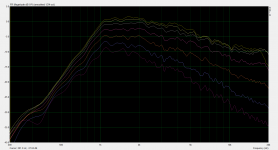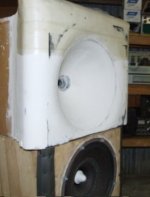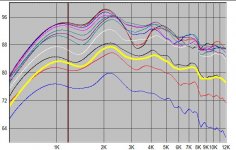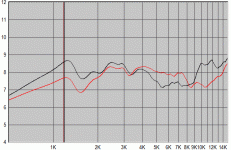I too believe that > 15 kHz.... are not resent in nature in general because of air absorption.
And then there is Jazz. The Internet Archive is filled with live minimalist recordings listed as better than Redbook audio. A lesson learned long ago was to play them into a software spectrum analyzer like WaveSpectra. Recordings that didn't pass through a 22 kHz brick wall filter are immediately obvious, even given the generally reduced ultrasonic response of popular microphones.
A cardioid woofer/mid with properly designed waveguide/tweeter section would qualify as having flat power response. And I can assure you it does not sound bright or coloured in any way (although a dipole does, but that's because it has other inherent problems).
Do you know any commonly used studio monitor with flat PR? I mean real flat all way up. What people call FLAT PR is 99% just gradually rising directivity. The difference is is just how smooth. Do you use 1/2 inch tweeter /wg throat/ or even smaller when not how you prevent beaming at >10khz? Only design with REAL flat PR are omnis /and mostly only horizontally/.
The funny thing is i know people for which is OS profile too hot at HF. I mean in sense that powerresponse dont fall up in highs. I think that everybody here agree that directivity must somehow rise with frequency and completely flat powerresponse will always sound too bright. Even JBL/harman agree and they even make falling to HF on-axis response as general recommended target. Its just a way that music is mastered at studios - they dont have flat power response monitors - such a monitor doesnt exist.
I make a LOT of experiment and completely agree with mr. Geddes that you cannot properly integrate supertweeter with WG. It is just not possible. /why do think JBL make new M2 without STW?/ If you make sudden changes in PR it is always sounds weird. And when you manage it without changes it will sound exact like without STW. If you use bigger throat or different profile /like i do/ i can understand you concern, but 1inch OS WG is about as wide as it get at HF - maybe proportionaly /mid to HF/ wider than 1 inch dome direct radiator.
You can make that 10db rise experiment very easy for your self just try EQ some music in PC. If you dont play from PC preprocess some files and burn it on CD.
Honesty i even think that everything 15khz and up just doesnt matter. And hear 19khz at nominal level. When you experiment with such a things you must use very steep filters than dont affect response below. For example when you hear 2th order low pass at 15khz you just hear changed response below 15khz. You must use at least 10th order. - try it.
Even then the response as shown it looks more like error for me. It will be quite hard to obtain such a response with passive crossover and compression drivers.
You pose the question "why do think JBL make new M2 without STW?"
I'd argue the answer is "because JBL has opted for a compression driver which is basically coaxial."
Here's the info on JBL compression driver from the M2, which sounds suspiciously similar to the BMS coax used in some of the Danley Synergy and Jericho horns:
http://www.jblpro.com/BackOffice/ProductAttachments/M2_Brochure_Jan2013.pdf

"Exceptional system performance requires extraordinary components. To achieve their groundbreaking objectives, the M2 design engineers capitalized on new, patented JBL technology in the D2 Dual Driver, a revolutionary device developed by JBL to deliver dramatically superior high frequency response. The D2 dual driver design allows the M2 to meet seemingly opposing objectives: extended high frequency, very low distortion and very high output.
Central to this innovative solution are two key developments. First: the use of an annular diaphragm, not subject to the break up modes of a conventional dome diaphragm. Second: the merging of two drivers into a single, compact transducer with a single acoustical output. Instead of the large and heavy metal dome diaphragm of a conventional compression driver, the D2430K uses two annular low-mass polymer diaphragms offering the
same radiating area as a conventional 3-inch dome. Two separate 3-inch voice coils driven by their own magnet structures share the burden of heat transfer, resulting in a dramatic increase of output and power handling. The
result is a high frequency transducer that produces smoother, extended high frequency response to 40 kHz and significantly lower levels of nonlinear distortion."
There is nothing really coaxial in D2 driver. Technicaly it is more push pull than coaxial. There are two diaphram with same size same motor and no crossover.
It is very very clever driver BTW.
Anyway even if it was coaxial like BMS - the limiting factor of power response at UHF is throat size. A can assure you that B&C 250 is at UHF at least as good as coaxial BMS - and i think it is better.
It is very very clever driver BTW.
Anyway even if it was coaxial like BMS - the limiting factor of power response at UHF is throat size. A can assure you that B&C 250 is at UHF at least as good as coaxial BMS - and i think it is better.
Last edited:
Something I always wondered, why are drivers with smaller throat size not more common? Older drivers like Vitavox had smaller throats.
Is it only because they can't go that low at full power? In a domestic environment this shouldn’t be a problem, as 1 watt of power is more than sufficient, and with a matching horn, I suspect you still would be able to get low enough.
IMO, a 1/2" compression driver with matching horn seems like the ideal “hifi” tweeter...
Is it only because they can't go that low at full power? In a domestic environment this shouldn’t be a problem, as 1 watt of power is more than sufficient, and with a matching horn, I suspect you still would be able to get low enough.
IMO, a 1/2" compression driver with matching horn seems like the ideal “hifi” tweeter...
Patrick,
The JBL is just there version of a knockoff. This is how they do business. Buy an existing product and use it until they develop their own version that is slightly different in-order to go around an existing patent and get their own. They will always do this, it is part of the corporate thinking at Harmon.
The JBL is just there version of a knockoff. This is how they do business. Buy an existing product and use it until they develop their own version that is slightly different in-order to go around an existing patent and get their own. They will always do this, it is part of the corporate thinking at Harmon.
Only thing that has D2 and bms in common is that they use annular phgram. Thats all. I was also thinking that it is knockoff but after close look it isnt.
There are many inherent problems with BMS coax driver - there are resonances in cavities which goes to phasing plug. These cavities are just way too big for smaller driver /bigger than wavelenght sound wave they reproduce/ There are also modulation from bigger phragm to smaller one /they are in one "pressure chamber" All these things dont apply for JBL driver - the push pull idea is so elegant simple...
About smaller throat. When you want to go lower - you must use bigger phgram. Big phragm to small throat means bigger compression ratio which lead to higher distortion due air nonlinearity. It will be just 2th order HD though. Compression drivers are almost exlusively for PA unfortunately. For home use a good 3 inch driver with inch throat will be bless. But new D2 has almost all - its just 1,4 inch - but it is throatless design - which mean a much better dispersion of HF is possible with right WG. This driver is much more advanced than any Berilium 5 slit hogo fogo overkill. Basicaly this is first major change in CD design since 1928 WE designs /BMS coax is expetion/.
There are many inherent problems with BMS coax driver - there are resonances in cavities which goes to phasing plug. These cavities are just way too big for smaller driver /bigger than wavelenght sound wave they reproduce/ There are also modulation from bigger phragm to smaller one /they are in one "pressure chamber" All these things dont apply for JBL driver - the push pull idea is so elegant simple...
About smaller throat. When you want to go lower - you must use bigger phgram. Big phragm to small throat means bigger compression ratio which lead to higher distortion due air nonlinearity. It will be just 2th order HD though. Compression drivers are almost exlusively for PA unfortunately. For home use a good 3 inch driver with inch throat will be bless. But new D2 has almost all - its just 1,4 inch - but it is throatless design - which mean a much better dispersion of HF is possible with right WG. This driver is much more advanced than any Berilium 5 slit hogo fogo overkill. Basicaly this is first major change in CD design since 1928 WE designs /BMS coax is expetion/.
TomTom,
Besides the ridiculous price it is hard to beat the sound of the TAD 703 driver which includes the diffraction lens. It is a very small format compression driver of conventional design with a super light weight vapor deposited beryllium diaphragm. If cost isn't an issue it is very hard to beat.
As for the JBL device even though it may be a new design it was influenced by the BMS which they were using previous to the current design. I would bet it was the inspiration for their new driver.
Besides the ridiculous price it is hard to beat the sound of the TAD 703 driver which includes the diffraction lens. It is a very small format compression driver of conventional design with a super light weight vapor deposited beryllium diaphragm. If cost isn't an issue it is very hard to beat.
As for the JBL device even though it may be a new design it was influenced by the BMS which they were using previous to the current design. I would bet it was the inspiration for their new driver.
Do you know any commonly used studio monitor with flat PR? I mean real flat all way up. What people call FLAT PR is 99% just gradually rising directivity. The difference is is just how smooth. Do you use 1/2 inch tweeter /wg throat/ or even smaller when not how you prevent beaming at >10khz? Only design with REAL flat PR are omnis /and mostly only horizontally/.
I have a 1" dome on a 120 degree waveguide. It does not start to beam until about 18 kHz. The directivity of the dome itself is not a problem because of the waveguide.
I have a 1" dome on a 120 degree waveguide. It does not start to beam until about 18 kHz. The directivity of the dome itself is not a problem because of the waveguide.
I find that incredibly hard to believe. Can you support it with real data? The wider the waveguide the less its control on the directivity and the sooner its ability to do that will fail. So what is possible at 45 degrees is impossible at 120.
There is nothing really coaxial in D2 driver. Technicaly it is more push pull than coaxial. There are two diaphram with same size same motor and no crossover.
It is very very clever driver BTW.
Anyway even if it was coaxial like BMS - the limiting factor of power response at UHF is throat size. A can assure you that B&C 250 is at UHF at least as good as coaxial BMS - and i think it is better.
Agreed about the DE250. What the problem is with coax is that the two diaphragms see each other and the interaction at crossover creates a mess in the throat in a critical frequency band. I had suspected that this would be the case when I saw the design but I was convinced to test it anyways. Sure enough, the polar response at crossover is a mess with no hope that it can be corrected with any form of electronics. The concept is flawed - sorry.
I've said it before and I'll say it again because it is worth repeating. Compression drivers are basically a commodity. There are scant difference between all of them and in substantial test a $2000 TAD was not preferred over a $100 B&C in the exact same system. The results were a wash - statistically no difference. Spend the extra money if you want, but please don't claim that "it sounds better" unless you have the reliable tests to prove that.
a_tewinkel,
Based on the diameter of a 1" dome your claim seems to be more than wishful thinking. Wavelengths smaller than the diameter will cause the dome to bend and these bending modes are part and parcel to the breakup modes of any dome tweeter whether they are soft or hard domes. Any study of dome tweeter diaphragm's shows this very clearly. A waveguide can help direct the wavelengths larger than dome diameter but above that point directivity is not affected truly by the waveguide to the affect you speak of. It just isn't physically possible to solve that problem. It is very similar to the problem of compressions driver exit diameter and waveguide coupling.
Based on the diameter of a 1" dome your claim seems to be more than wishful thinking. Wavelengths smaller than the diameter will cause the dome to bend and these bending modes are part and parcel to the breakup modes of any dome tweeter whether they are soft or hard domes. Any study of dome tweeter diaphragm's shows this very clearly. A waveguide can help direct the wavelengths larger than dome diameter but above that point directivity is not affected truly by the waveguide to the affect you speak of. It just isn't physically possible to solve that problem. It is very similar to the problem of compressions driver exit diameter and waveguide coupling.
Acoustic Hyperbole
I suspect that during assembly an also over time, these units will exhibit or develop later, air leaks between the adjoining surfaces of their laminar construction. In compression drivers, such leaks in the high pressure cavities surrounding the diaphragm will 'kill' the acoustic output delivered into a horn. Holding dimensional tolerances across the driver 'stack' assembly must be a nightmare as well. For these reasons, excessive reject rates in production may be expected. These may be the main contributor to the high unit cost.
Regards,
WHG
You pose the question "why do think JBL make new M2 without STW?"
I'd argue the answer is "because JBL has opted for a compression driver which is basically coaxial."
Here's the info on JBL compression driver from the M2, which sounds suspiciously similar to the BMS coax used in some of the Danley Synergy and Jericho horns:
http://www.jblpro.com/BackOffice/ProductAttachments/M2_Brochure_Jan2013.pdf

"Exceptional system performance requires extraordinary components. To achieve their groundbreaking objectives, the M2 design engineers capitalized on new, patented JBL technology in the D2 Dual Driver, a revolutionary device developed by JBL to deliver dramatically superior high frequency response. The D2 dual driver design allows the M2 to meet seemingly opposing objectives: extended high frequency, very low distortion and very high output.
Central to this innovative solution are two key developments. First: the use of an annular diaphragm, not subject to the break up modes of a conventional dome diaphragm. Second: the merging of two drivers into a single, compact transducer with a single acoustical output. Instead of the large and heavy metal dome diaphragm of a conventional compression driver, the D2430K uses two annular low-mass polymer diaphragms offering the
same radiating area as a conventional 3-inch dome. Two separate 3-inch voice coils driven by their own magnet structures share the burden of heat transfer, resulting in a dramatic increase of output and power handling. The
result is a high frequency transducer that produces smoother, extended high frequency response to 40 kHz and significantly lower levels of nonlinear distortion."
I suspect that during assembly an also over time, these units will exhibit or develop later, air leaks between the adjoining surfaces of their laminar construction. In compression drivers, such leaks in the high pressure cavities surrounding the diaphragm will 'kill' the acoustic output delivered into a horn. Holding dimensional tolerances across the driver 'stack' assembly must be a nightmare as well. For these reasons, excessive reject rates in production may be expected. These may be the main contributor to the high unit cost.
Regards,
WHG
If you give the D2 more than a glance you will see they are not as similar as you think, they are not a copy.
As for a compression tweeter with a 1/2" throat? The JBL 076/2403 and 2404 are just that.
I agree, but those are not designed to go low. A vitavox GP1 driver (0.625") could get quite lot and was used on a relative big multi-cell horn. Of course, these are old, and I am not saying these are sound/measure very good (I have a pair with multi-cell horn, and also a Geddes OS12, the OS wins hands down).
But if we had a modern OS horn with a newly designed 1/2" driver that would reach 1200Hz, this would seem like the optimal solution for a Abbey size speaker...
Here's the raw measurements of my waveguide on a baffle with a 25 mm radius, 0-90 degrees in 15 degree steps. Just above 20 kHz the dome starts to break up, because of that the dispersion starts to widen again already slightly below 20 kHz. There's very mild narrowing above about 10 kHz, but I'd say big differences only appear just below 20 kHz...
Attachments
Last edited:
I have radiused my waveguide. I noticed a reduction in content around 1k, and I assume that's a good thing.
I'd like to know what the peak (2k) and dip (1k3) are from. The waveguide (under construction, 15" woofer for reference, power in yellow (response level not absolute)) is OS, I hope, down to 1k3 where the perspex ends in the photo with a conical profile until the roundover. IIRC the mass rolloff of the DE250 happens here but I don't recognise the response profile well enough as yet.
I'd like to know what the peak (2k) and dip (1k3) are from. The waveguide (under construction, 15" woofer for reference, power in yellow (response level not absolute)) is OS, I hope, down to 1k3 where the perspex ends in the photo with a conical profile until the roundover. IIRC the mass rolloff of the DE250 happens here but I don't recognise the response profile well enough as yet.
Attachments
Last edited:
- Home
- Loudspeakers
- Multi-Way
- Geddes on Waveguides



